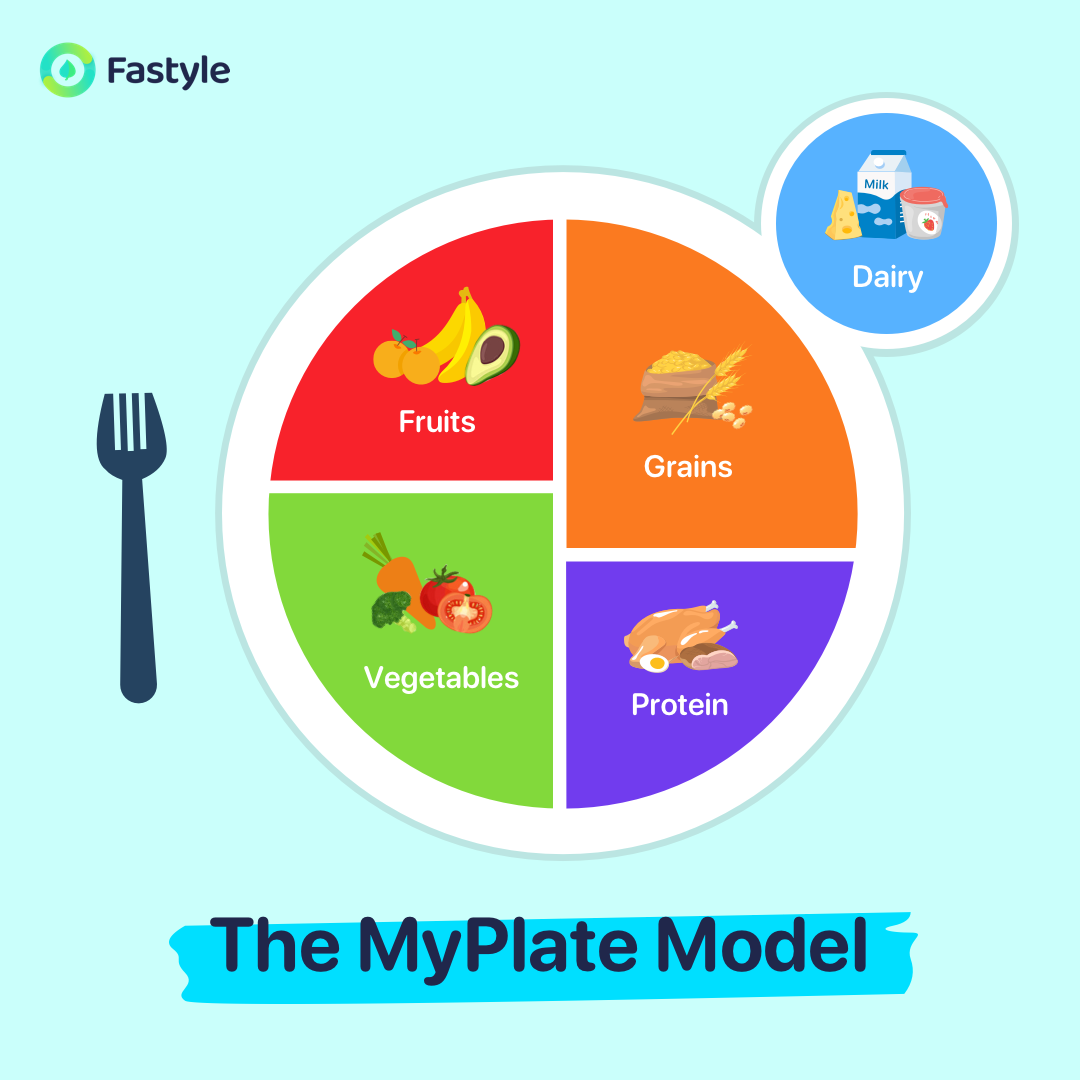We have discussed the key components of healthy eating while you’re on intermittent fasting to get the best nutrition. It is easy to talk about what you should eat while putting it into practice is totally different. How do you incorporate all these food groups to make sure you’re getting enough nutrients, yet keeping the calories limits to lose weight? In this article, I will talk about some practical advice on eating a balanced meal for weight loss during intermittent fasting.
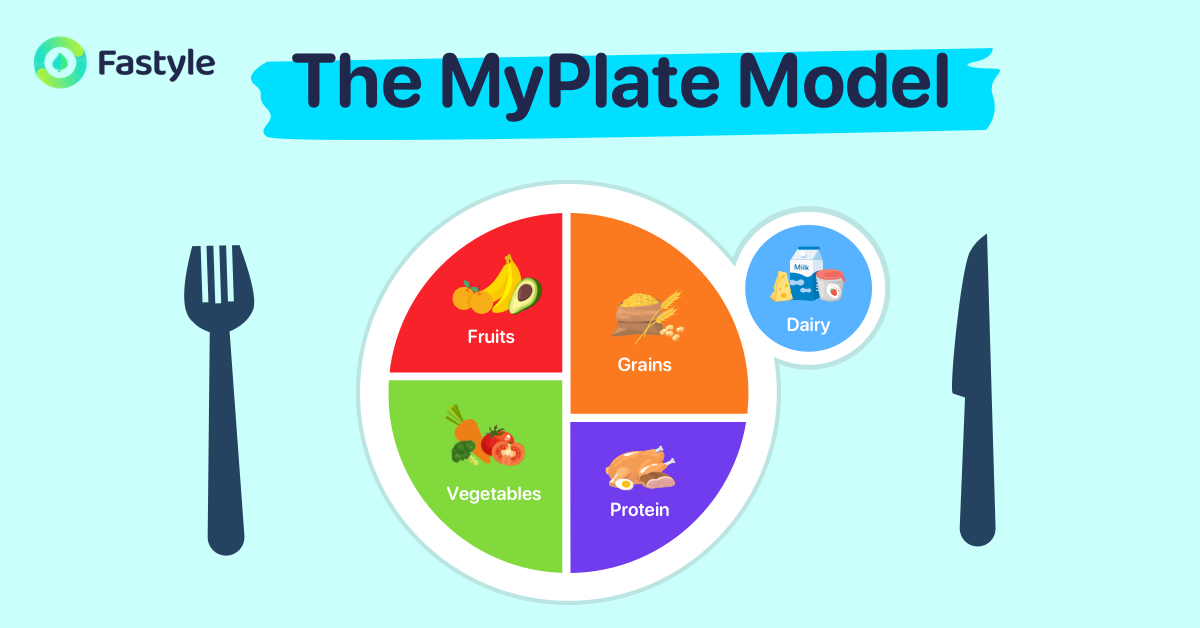
The MyPlate Model
The Dietary Guidelines for Americans recommends healthy dietary patterns with nutrient-dense foods including fruits and vegetables of all types, grains, dairy, protein foods, and oils. To practically balance these food groups on your plate, I recommend you use the MyPlate model designed by USDA based on the dietary guideline. The MyPlate model recommends making half of your plate fruits and vegetables of all variety, about a quarter of your plate grains, with half of them should be whole grains; a quarter your plate protein foods and vary your routine; finally, choose low-fat or fat-free dairy or alternatives. The figure below clearly indicates what MyPlate should look like.
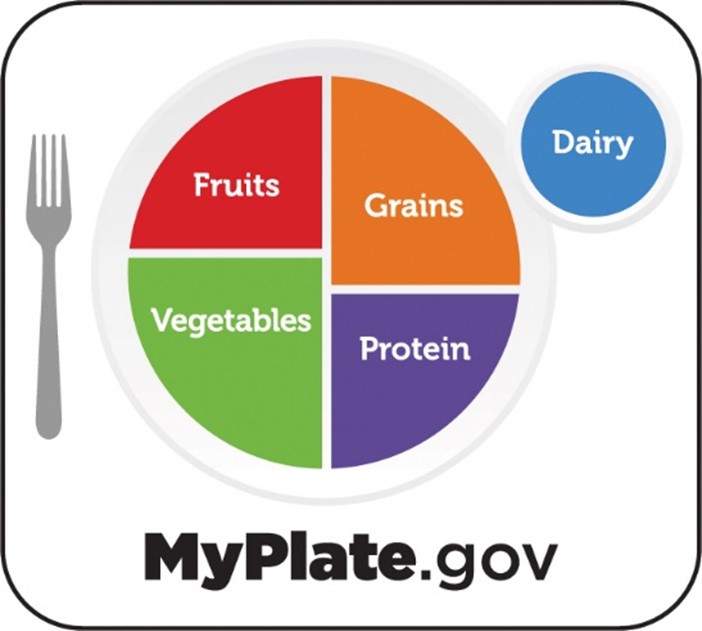
Using such a model can not only help you incorporate the five food groups in variety but also help you to control portions and calories for weight loss.
What Should be Placed on Your Plate
Here are some practical things you can try to do in order to follow the model for healthy eating.
Fruits
- Choose whole fruit over fruit juice
- Choose from a variety based on color
- Start your day with a piece of fruit
- Snack on a piece of fruit (e.g. keep them on hand, sliced fruits ready for snack)
- Add fruit to your salad (e.g. grapes, sliced apple, orange, melon, pineapple)
- Have fruits for a sweet treat (or use to swap out cookies, ice-cream or desserts)
- Frozen fruit, with yoghurt as snack
- Bake/sauté apples or pear with cinnamon
- Frozen banana soft serve
- Have fruit with your main meals: breakfast, lunch, or dinner.
- Add frozen, canned, or dried fruit to your meal/snack/smoothie
Vegetables of all types
- Choose from a variety based on color
- Add vegetables to your main meals: breakfast/lunch/dinner. Try sauteing, steaming or fresh salad.
- Have a dark green vegetable
- Have a red or orange vegetable
- Start your day with a vegetable (in any form)
- Add beans, peas, or lentils in your salad or side dishes
- Add vegetables fresh, frozen, or diced vegetables in your dishes/smoothie (e.g. adding beans, diced vegetables in chili, soup, salad, pasta sauce)
- Snack on vegetables salads, veggie sticks, stir-fry/steamed vegetables.
Grains
- Choose at least half are whole grain
- Look for words like “whole grain”, “whole meal”, “multi-grain” or “Whole meal, whole grain”
- Try a new whole grain, may choose from oats, quinoa, farro, brown rice, buckwheat, millet, bulgur (cracked what), barley, whole-wheat/whole-meal pasta, bread, crackers, cereals…
- Start your day with grains
- Enjoy whole grains in different ways (e.g. use whole wheat flour, whole wheat pasta, whole grain bread, rolls, pitas, and tortillas)
- Have whole grains at main meals: breakfast/lunch/dinner.
- Have grains for snacks (e.g. multigrain rice cakes, crispbread, crackers, toast)
- Have a grain with another food group (e.g. with a protein food or vegetables side dish)
Protein foods
- Choose lean protein, including meats (trim off visible fats), poultry (without skin), eggs, fish, seafood, nuts and seeds, beans, peas, lentils and soy products.
- Have a serve of lean protein at main meals: breakfast/lunch/dinner.
- Have a protein food with another food group (e.g. side with grains or vegetables)
- Start your day with a protein food (e.g. eggs, beans, sliced turkey/lean meats)
- Have a protein as a snack (e.g. soft boiled egg, a small handful unsalted nuts, roasted chickpeas and hummus)
- Vary your protein routine with beans and peas (e.g. adding beans and lentils in soup, curry and salad)
- Have a seafood dish at least once a week, preferably oil fish.
- Enjoy nuts, seeds, and soy products.
Dairy
- Choose low fat or fat-free dairy, lactose-free dairy or fortified unsweetened plant-based alternatives.
- Have dairy as part of your meals: breakfast/lunch/dinner. (e.g. Greek yoghurt for dressing, add cheese to dishes, side with milk beverages)
- Start your day with dairy
- Snack on dairy (e.g. milk based smoothie, cottage cheese, yoghurt)
- Have dairy with another food group (e.g. side with fruit, cracker or added to main dishes)
- Consider lactose-free dairy and fortified unsweetened plant-based alternatives
Oils
Oil is also part of a healthy diet. Although it is not shown on the MyPlate model, it is added to foods on your plate. Choosing healthy oils can help your body absorb fat-soluble nutrients, reduce the risk of heart disease and improve blood lipid profile when used to replace saturated fat.
Because oils and fats provide the same calorie when eaten the same amount, it is better to have oils in moderation, enough to get its nutrition benefits without consuming too many calories when you’re trying to lose weight.
- Use mostly vegetables oils for cooking instead of fats such as butter, ghee or lard.
- Reduce or replace fat in recipe with oils. (e.g. use olive oil in banana bread instead of butter)
- Try a new oil for salad dressing, such as sesame oil, flaxseed oil.
- Use oil spray to reduce oil used for cooking.
- Common vegetable oils include olive oil, canola, avocado, sesame, peanut, sunflower, soybean, corn, safflower and walnut oil.
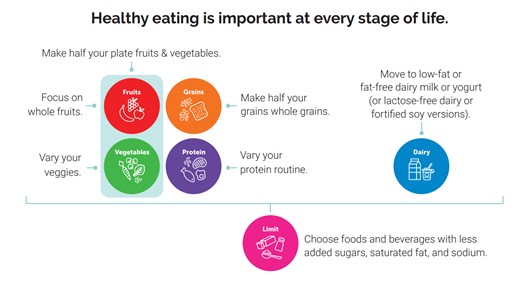
Things to limit
Apart from the five basic elements contributing to MyPlate, other important elements from the Dietary Guidelines for American and healthy lifestyle, include limits on added sugar, saturated fat, sodium, and alcoholic beverages.
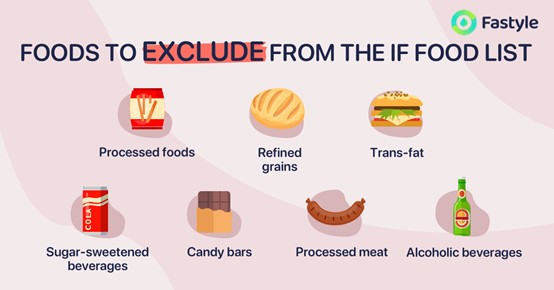
Added sugar
- Choose less processed food, e.g. choose plain yoghurt instead of yoghurt with added sugar.
- Have whole food instead of processed food, e.g. plain rolled oats instead of instant oats/breakfast cereals with added sugar.
- Look for “no added sugar”, “sugar-free”, “reduced-sugar” products.
- Compare food labels and choose products with the lowest amount of added sugar, e.g. breakfast cereals, reduced-sugar syrups, jams, jellies.
* Sugar also commonly goes by brown sugar, corn sweetener, corn syrup, dextrose, fructose, glucose, high-fructose corn syrup, honey, invert sugar, malt syrup, maltose, raw sugar, sucrose…
- Toss the table sugar
- Swap out the soda, sports/energy drinks, fruit drinks, and other sugar sweetened beverages
- Reduce serving for your sweet treats, soda, sugar in your coffee/tea
- Snack on fresh fruits, instead of cookies or cakes.
- Try extracts and spices in your recipe to enhance flavor, such as vanilla, peppermint, almond extracts, cinnamon, nutmeg.
- Try non-nutritive sweetener but limit its use.
Saturated fat
Examples of foods with saturated are:
- Fatty beef, lamb, pork
- Poultry with skin
- Deli/processed meat (e.g. bacon, sausages)
- Beef fat (tallow)
- Pork fat (lard)
- Butter, ghee
- Coconut oil and palm oil
- Cheese and other dairy products made from whole or reduced fat (2%) milk
Eat less saturated fat
- Trim visible fat on meat and take the skin off poultry
- Compare food labels and choose foods with lower fat/saturated fat.
- Choose lower fat, reduced fat or fat-free dairy products or plant-based dairy alternatives
- Grill, bake, poach, sauté, stir-fry or steam food instead of deep drying or roasting.
- Swap out your butter or chocolate spread to nut butter or reduced fat spread, such margarine based on olive oil or sunflower oils.
Sodium
You don’t have to do everything below to be healthy, only a few of them can help you reduce sodium intake for general healthy eating. Only people with hypertension (high blood pressure) need to significantly reduce their sodium intake.
- Toss out the table salt
- Pick fresh and frozen unmarinated meats.
- Drain and rinse canned beans and vegetables if possible
- Use onions, garlic, herbs, pepper, spices, citrus juices and vinegars to enhance flavor to avoid using excessive salt and sauces.
- Compare food labels and choose foods with lowest amount of sodium
- Choose canned food labeled “no salt added” and frozen food without salty sauces.
- Choose “reduced salt” version of sauces, broth, stocks and stock cubes for cooking.
Alcoholic beverages
- Set a drink limit, 2 drinks or less in a day for men, and 1 drink or less in a day for women.
- Drink slowly
- Keeping counts on your drinks
- Have a few days a week alcohol free
- Swap to lower or nonalcoholic beverages, this can be a lower strength drink, to a mocktail.
- Don’t keep alcohol in your house
Draw your menu
I have talked you through the MyPlate model, what you should eat and what you should limit and have in moderation. It is now your turn to pick all those strategies and put them into practice by drawing your own plate and fill out what you’re going to eat in each food group. So, let’s rewind, fill half of your plate with fruits and vegetables, about a quarter with grains (preferably whole grain), and the other quarter with lean protein foods, and choose low-fat/fat-free dairy products. Simple, right? Give it a try here with the blank plate.
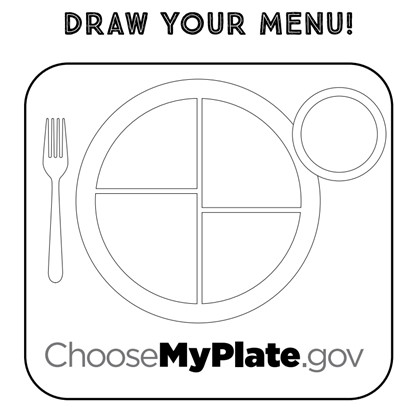
Summary
- Follow the MyPlate model, fill 50% of your plate with fruits and vegetables, about 25% with grains, 25% with lean protein and choose low-fat/fat-free dairy or alternatives.
- Choose healthy oil and use mostly vegetables oils in cooking.
- Limits added sugar, saturated fat, sodium and alcoholic beverages.
- Choose strategies that suit you, you don’t have to do everything, only a few of the strategies in this article can help you achieve healthy eating.
- Try draw your own plate with the MyPlate model!
Reference:
https://myplate-prod.azureedge.net/sites/default/files/2020-12/MyPlatePlanMenuTemplate.pdf
FOLLOW US
